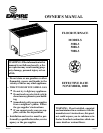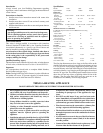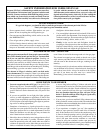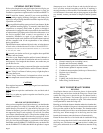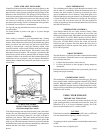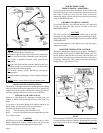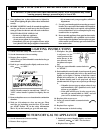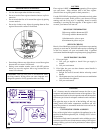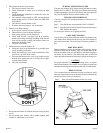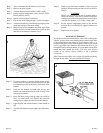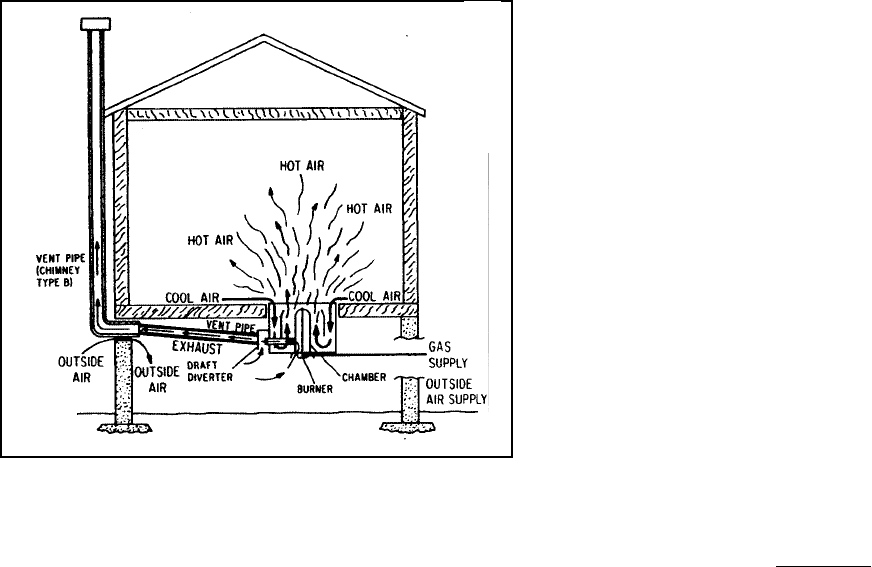
R-1842 Page 5
WALL THERMOSTAT
The wall thermostat is simply a switch that turns on when it is cold
and off when it is comfortable. When the thermostat turns on it
connects the small amount of electricity to the main gas valve
(part of combination valve in furnace), which then opens. Now
the pilot lights the gas and your furnace is on. When the living area
is warm enough, the wall thermostat switches off, the main gas
valve closes and your furnace turns off. The pilot remains lit
waiting to light the gas the next time the thermostat calls for heat
and turns the furnace on.
TEMPERATURE CONTROLS
Your Empire furnace has two safety switches (limits). When
either switch turns off, it turns your furnace off, even if the wall
thermostat is calling for heat. One of these switches can be moved
to a LOW HEAT or a FULL HEAT position. In FULL HEAT
position the register becomes very hot when the furnace heats the
living area. In LOW HEAT position the switch will turn the
furnace off and on again a few times before the living area is
comfortable but it stops the register from getting as hot as the
FULL HEAT position.
DRAFT DIVERTER
The draft diverter is a collection box that is attached to the exhaust
end of your furnace. The draft diverter is a very important unit and
has two major functions:
1. It dilutes the flue products with cooler air.
2. It allows the furnace to burn properly during temporary
downdrafts.
Check the draft diverter and entire vent system each year for rust
damage and proper assembly.
COMBINATION VALVE
The combination valve in the furnace controls the gas. This valve
has a control handle with three positions marked: OFF, PILOT
and ON. When the handle is at OFF, all gas is cut off. When the
handle is at PILOT, the pilot can be lit. When the handle is at ON,
the gas will flow to the burner providing the pilot is lit and the wall
thermostat calls for heat.
USING YOUR FURNACE
BEFORE YOU TURN IT ON
Look down inside your furnace and make sure there isn't any
paper, packing material, or trash that could catch fire. Turn your
thermostat off or to its lowest temperature setting. See if the
furnace control handle (see C) is turned to OFF.
CAUTION
If the furnace control handle was not at OFF, turn it to OFF and
wait ten minutes before lighting a match or the pilot.
NOTE
You must press down on the furnace control handle to make it turn
to OFF.
You are now ready to light the pilot.
INSULATED VENT ENCLOSURE
Vented floor furnace installed with the vent going directly to the
outside and above the eaves can cause poor venting. The cold vent
pipe will have a delay in proper venting and cause spillage of flue
products at the draft diverter. The spillage of flue products can
result in pilot outage due to recirculation of flue products into the
main burner, also, condensation can occur in the vent pipe which
can cause an ice build-up or rusting of the draft diverter. To
prevent delayed venting as well as condensation of flue products
an insulated vent enclosure is recommended.
Use Type B vent pipe and maintain at least a one inch clearance
to combustibles.
Use metal thimble to protect vent pipe as it passes through
combustibles.
VENTING
Good venting is essential to good dependable heat. Venting
removes the exhaust that results when gas is burned inside your
furnace. If the exhaust is not vented away, the exhaust may gather
under your house and could seep into the house and be fatal.
Venting is done through a vent pipe (chimney) which, when
correctly installed, causes a draft (suction) at the end of the pipe
that is connected to the draft diverter. This suction carries away
the exhaust from your furnace. The vent pipe is connected to the
draft diverter (see B) which is mounted onto the furnace during
installation. Refer to the Installer and Serviceman's Manual for
instructions on how to properly vent your furnace. Remember,
exhaust fumes, whether they come from your furnace or your car,
can be fatal.
B
FURNACE FEATURES
NO ELECTRICITY NEEDED
(Self Generating Pilot Control)
Your Empire furnace does not need electricity from your house;
it makes its own. When the pilot is lit, its heat is used to generate
a tiny amount of electricity (about 1/2 volt) which is all that is
needed by your furnace. This small amount of electricity keeps
the pilot valve (part of combination valve in furnace) open so the
pilot stays on. The small amount of electricity is also used with the
wall thermostat to turn on the furnace automatically when heat is
needed, and turn it off when it is comfortable.



